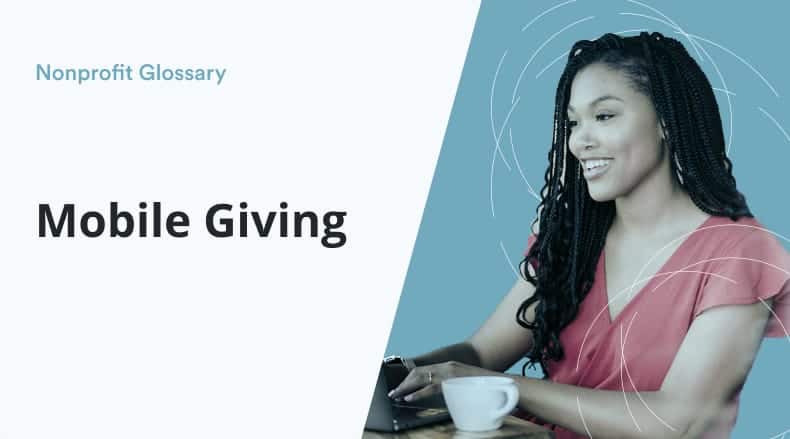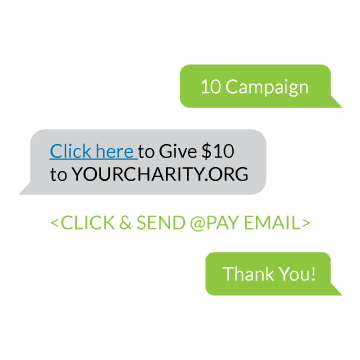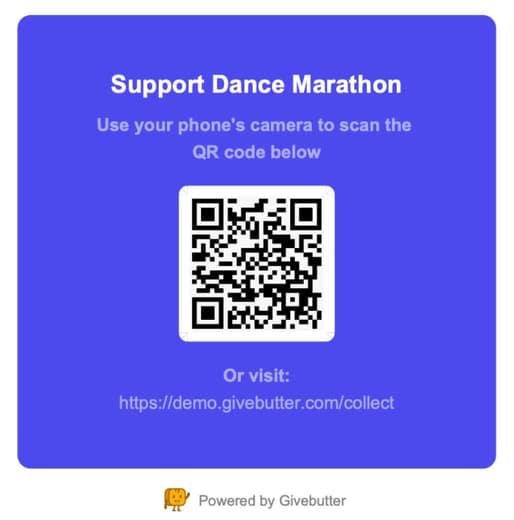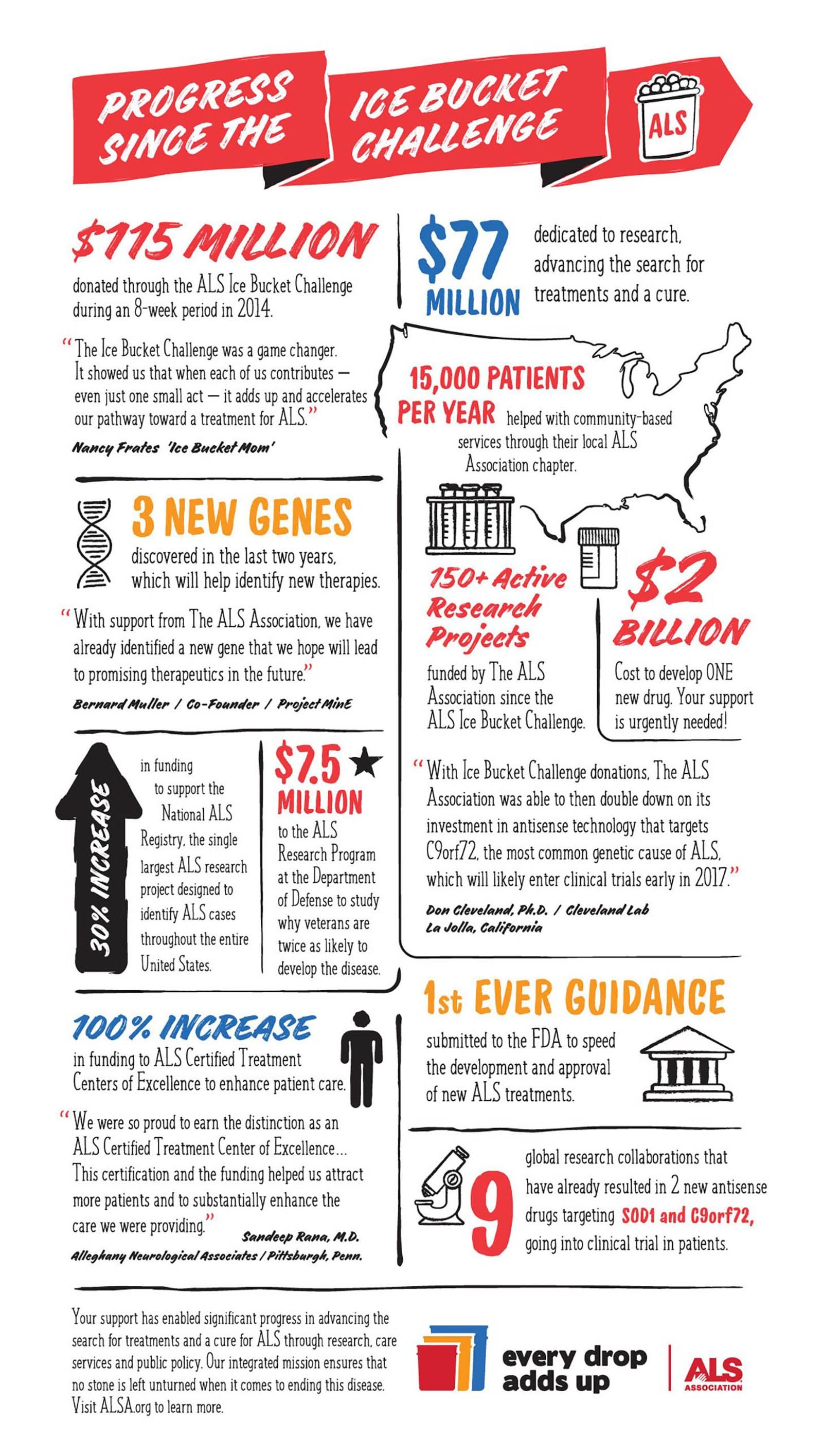Mobile Giving

What is mobile giving?
Mobile giving, also known as mobile fundraising for nonprofits, is when you use technology to allow donors to give from their smartphone. It makes donating more comfortable and faster in a wider variety of situations. Mobile giving is a link between in-person and online fundraising because it allows you to collect donations in situations like live events using online giving technology. It also provides a way to keep donors engaged with your campaign and stay in contact for future fundraisers.
With the majority of internet users browsing on their phones, any fundraiser can benefit from making it easier to give via their handheld devices.
There are several ways to offer mobile giving.
Text-to-donate
Text-to-donate enables donors to request a donation link by texting a keyword to your SMS number.

After receiving the link via SMS, donors fill out a short form to provide their payment info and then authenticate the payment via email. This lets any organization offer a simple step-by-step process for donating on a smartphone.
Text-to-give
Text-to-give makes mobile giving even more comfortable, but your organization must meet a few requirements to be eligible to use it.
Using text-to-give, donors text your SMS donation number with a keyword and the amount they want to donate, which is usually limited to increments of $5. Although donations start at a small size, the average text-to-give donation size is $107. This amount is then added to their next phone bill. As a result, there is no need to provide payment info or authenticate the transaction. This is ideal for live events where filling out a payment form can distract people from participating.
QR code donations
You can also send people to your donation page using a QR code. By scanning the code with their phone’s camera, donors will be taken to a payment form to donate.

Source: Givebutter
QR codes can be added to any visual media to provide a cashless donation method or make it easier to set up ongoing payment. For example, you could add a QR code to your event posters and flyers or your online videos and social media posts.
Social media fundraising
Social media sites offer platform-specific tools for charities, such as Facebook’s Charitable Giving Tools and Instagram’s donation stickers and fundraising campaigns.
While not solely used via phones, social media fundraising is an ideal way to increase mobile giving. Of the 4.2 billion mobile internet users, more than 90% regularly use social media. Furthermore, social media charity tools enable and encourage donors to share their donations with their friends and followers, raising awareness for your cause and driving additional donations from their social network.
How can mobile giving support your fundraising?
Smartphones can also support your fundraising in other ways providing mobile giving methods. With the right approach, you can use SMS and social media to keep your donors more engaged, increase awareness of your campaigns, and stay in touch with donors without meeting in person.
SMS donor engagement
Include the option to opt into your SMS subscriber list on all of your donation forms to stay in touch with donors between campaigns. Using a formless mobile giving method like text-to-give includes a keyword to subscribe in your thank you text.
This allows you to text donors to ask for further donations, inform them about future campaigns, raise attendance at events, and increase awareness of other fundraising methods. For example, SAWA-Australia uses texting to notify subscribers of upcoming fundraiser events and direct supporters to their online shop.
SMS can also increase engagement with your cause by sharing news and updates and following up to share the results of the campaign they donated to. Showing the impact of their contribution assures donors that their money is making a difference, increasing the chance of future donations.
Promote upcoming fundraiser events
An SMS subscriber list helps you keep track of the donors who want to be involved in your future work. Beyond letting them know about your upcoming campaigns, this is an excellent opportunity to ask them to take a more active role in helping your fundraiser.
You can:
- Ask subscribers to share your texts and social media posts with their friends and family.
- Invite subscribers to volunteer their time at events or help out with transportation.
- Find advocates to promote your campaign in their local community or workplace.
Building an SMS subscriber list of past donors can give you access to a wide range of skill sets, social networks, and connections with businesses and other charitable organizations. You never know who might be willing to volunteer their time and skills or leverage their relationships for your cause, so it is always a good idea to stay in touch with donors.
Raise awareness using social media
According to statistics, 1 in 4 donors uses their phone to discover nonprofits they were not aware of.
Social media platforms can introduce your fundraiser to millions of people by building an audience and encouraging them to share your posts, especially if your content goes viral. Contests, challenges, and other content that social media users can participate in are great ways to draw your organization’s attention. The ALS Association’s Ice Bucket Challenge is perhaps the most well-known example of this, raising $115 million, and many others have followed.

Source: Canva
Social media sites can also help through paid ads. Sites like Facebook enable you to reach out to people based on a vast range of demographic data, letting you focus on groups most likely to donate to your cause.
Preparing your campaign for mobile giving
This approach is most effective when your campaign is ready to support smartphone users fully. Mobile giving methods should make donating easier, but they won’t if your website design, communication, and payment tools aren’t updated and optimized
Responsive design
Responsive design adapts the layout and formatting of your site pages according to a user’s device. Using easily-tapped buttons instead of links and minimizing text blocks make pages much easier to use on the phone because it reduces the need to scroll and zoom. Making sites responsive can increase mobile giving by 126%. Conversely, most phone users take just a handful of seconds to decide your site is too slow or difficult to navigate and leave.
Improving usability also includes your online forms. Hubspot’s study showed that reducing the number of fields from 4 to 3 can increase responses by 50%, eliminating unnecessary areas and including autofill support and login via Facebook and Google accounts to simplify the process. Most payment processors already provide these features.
Communication
Texting and instant messaging enable rapid and more personal communication with donors. As a result, SMS gets more responses faster than email.
While not quite as personal as a phone call, a text conversation is much more convenient for donors, as they can reply when it suits them. Furthermore, while you can only call one donor at a time, you can text hundreds of people at the same time using a charity SMS marketing solution.
Data management
To gain donor trust, it’s important a secure way to process payments, store customer data, and enable donors to update their information quickly. Nonprofit CRMs like Kindful make donor management easy, keeping everything in one place, making it easier to track every detail of your campaign, and use data to understand your donors better.
Bottom line
Mobile giving is more than just another way to process payments. It encourages donations in a broader range of scenarios, such as live events or print advertising. Getting creative with the way you incorporate mobile giving into your campaign will help you maximize funds for your organization.